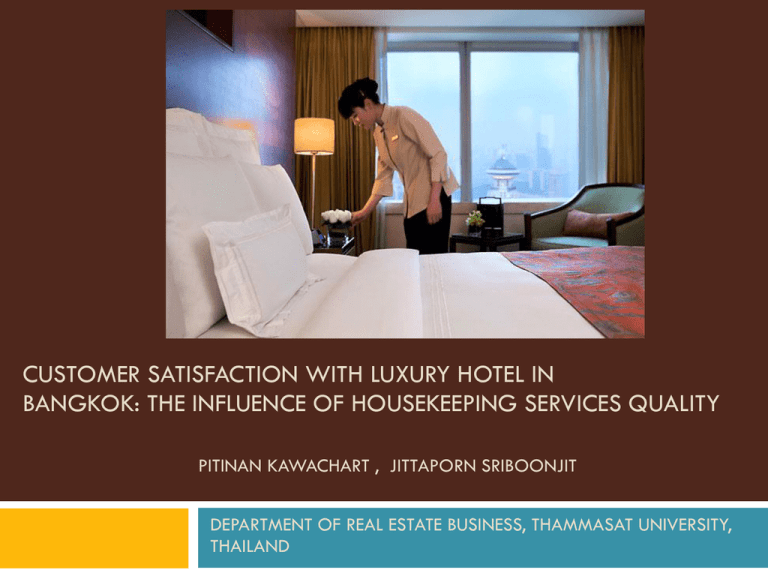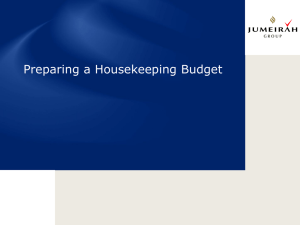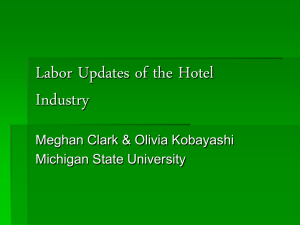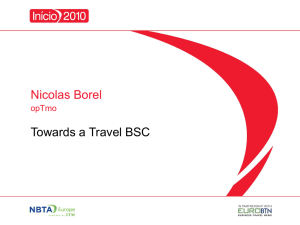Customer Satisfaction with Luxury Hotel in Bangkok
advertisement

CUSTOMER SATISFACTION WITH LUXURY HOTEL IN BANGKOK: THE INFLUENCE OF HOUSEKEEPING SERVICES QUALITY PITINAN KAWACHART , JITTAPORN SRIBOONJIT DEPARTMENT OF REAL ESTATE BUSINESS, THAMMASAT UNIVERSITY, THAILAND Introduction Bangkok, The Capital of Thailand received the World Best’s City Award three times in a row, Year 2010 – 2012 (Marsh, 2012) The top city hotel award in Asia from 2008 – 2012 belonged to the luxury hotel in Bangkok (Marsh, 2012) Nowadays the rapid growth and increasing of hotel supply comes with higher competition, causing hoteliers try to capture the market share by using price cutting strategy. The intense price discounting could run a serious risk of having negative impact on the hotel’s long–term profitability. The hotel segment that critically affected by this circumstance, is the luxury class hotel. The occupancy rate and room rate begin to go down. Introduction Another key to help gaining a market share from competitors is a focus on services quality through a hotel’s ability to differentiate itself by providing unique benefit to customers. The customer satisfaction is one of the most important factors affecting the hotel business performance, as it is the main driver of customer loyalty. The high level of customer satisfaction lead to repurchase and favorable word-of-mouth publicity and eventually increase in the revenue. (Gundersen & Heide, 1996; Jay & Dwi, 2000; Markovic & Raspor, 2010; Swan & Oliver, 1989) Introduction The hotel service department consists with three departments, which are the reception, food and beverage and housekeeping department. Many past research papers has studies on the quality of these service departments toward the customer satisfaction (Engeset & Heide, 1993; Gundersen & Heide, 1996; Jay & Dwi, 2000; Oh & Mount, 1998; Wang & Pearson, 2002). Jay and Dwi (2000) claimed that the hotel guests perceived customer satisfaction with housekeeping to be more important than satisfaction with reception and food and beverage when deciding whether to return and recommend. But the housekeeping is not traditionally considered by hotel manager as a front-line service department. Introduction Therefore, service training offered to housekeeping staff is minimal in comparison with that provided for reception and restaurant staff. Few research studies have focused and identified which elements of housekeeping service quality that significantly influence a customer satisfaction in this department (Jay & Dwi, 2000). This paper will particularly explore the factor of housekeeping service quality helping the hotel managers to enhance the housekeeping service performance and ultimately customer satisfaction of the luxury hotel. Introduction Classification of Hotel in Bangkok by CB Richard Ellis (Thailand) Luxury : Average Daily Room Rate (ADR) of over THB 5,500 (approx. USD 170). Most luxury hotels are located on main roads in CBD and are managed by international hotel operators under their premier brands. The target market includes high income leisure and executive business travelers. Introduction Classification of Hotel in Bangkok by CB Richard Ellis (Thailand) First Class : Average Daily Room Rate (ADR) of THB 4,500-5,500 (approx. USD 140-170). Most first class hotels are located on main roads in the CBD. These hotels are managed by a premium international hotel brand or local hotel operator. The target market ranges from upper-middle-income to high-income leisure and business travelers. Introduction Classification of Hotel in Bangkok by CB Richard Ellis (Thailand) Mid-range: Average Daily Room Rate (ADR) of THB 2,500 – 4,500 (approx. USD 80-140). The hotels are either located on main road or in streets between main roads in the CBD and the vicinity. The hotels are managed by a mid-rage international hotel brand or local hotel operator. The target market includes middle-income leisure and business travelers. Introduction Classification of Hotel in Bangkok by CB Richard Ellis (Thailand) Economy: Average Daily Room Rate (ADR) of THB 1,000 – 2,500 (approx. USD 30-80). Most economy hotel are located in streets between main roads in the CBD and the vicinity. Economy hotels are either managed by an entry-level international hotel brand or a local operator. The target includes budget leisure and business travelers. Literature Review Perceived Service Quality A generic measure of service quality, the SERVQUAL scale was developed by Parasuraman et al. (1985, 1988). Their aim was to provide a generic instrument for measuring service quality across a broad range of service categories. Parasuraman et al. (1985) reported that consumers evaluated service quality by comparing expectations (of service to be received) with perceptions (of service actually received) on ten dimension: tangible, reliability, responsiveness, communication, credibility, security, competence, understanding/knowing customers, courtesy, and access. Literature Review Perceived Service Quality In a later Parasuraman et al. (1988) work, the authors reduced the original ten dimensions to five. Each dimension is measured by five items (a total of 22 items across the five dimensions). The definitive five dimensions were: 1) Tangible: the appearance of physical facilities, equipment, and personnel. 2) Reliability: the ability to perform the promised service dependably and accurately. 3) Responsiveness: willingness to help customers and provide prompt service. 4) Assurance: the knowledge and courtesy of employees, and their ability to inspire trust and confidence. 5) Empathy: the level of caring and individualized attention that the firm provides to its customers. Literature Review Perceived Service Quality SERVQUAL has been used to measure service quality in a wide range of service industries, which included - Health care sector (Carman, 1990; Headley & Miller, 1993) - Fast food (Lee & Ulgado, 1997) - Banking (Lam, 2002) - Telecommunications (Wal, Pampallis, & Bond, 2002) - Information systems (Jiang, Klein, & Crampton, 2000) - Retail chain (Parasuraman, Zeithaml, & Berry, 1994). Literature Review Perceived Service Quality For the case of hotel service industry, there was a variable support for the validity of the SERVQUAL model. For example, Wuest et al (1996) applied the SERVQUAL model in the hotel industry in United States to evaluate the importance of services provided. The authors reported that 5 dimensions found to be relevant and appropriate. However, the study of SERVQUAL model in the hotel industry in Cyprus indicated that only ‘tangible’ was relevant. The other dimensions (reliability, assurance, responsiveness and empathy) were collapsed into only one dimension which designated as intangible (Riadh, 2012; Wuest, Tas, & Emenheiser, 1996). Literature Review Hotel industry-specific measure of service quality Many of research paper, has been developed by adapting SERVQUAL or using SERVQUAL as a foundation for developing new instruments for measuring hotel service quality (Getty & Thompson, 1995; Khan, 2003; Oberoi & Hales, 1990). For instance: Oberoi et al. (1990) proposed two types of perceived service quality attributes: physical (technical) attribute and non-physical (functional) attribute. Examples of technical attribute are the equipment availability, general facility cleanness, and quality and quantity of food. Examples of functional attributes are the reliability of hotel staff and management, staff assistance, and management attention to visitor’s need Literature Review Hotel industry-specific measure of service quality For instance: Getty et al. (1995) identified three basic dimensions of lodging quality which were tangible, reliability and contact (LOGDQUAL). The tangible and reliability dimensions were as previously defined. The contact dimension is composite of SERVQUAL’s responsiveness, empathy and assurance dimensions Khan (2003) proposed ECOSERV model from investigating the service-quality expectations of ecotourists and reported six dimensions, including so-called “eco-tangible” dimension. Literature Review The Lodging Quality Index and Its Relation to Customer Satisfaction The lodging quality index (LQI) is a multidimensional scale developed by Getty et al. (2003) on the basis of SERVQUAL model. The process of the LQI scale began with 10 dimensions that was originally in the first version of SERVQUAL (Parasuraman, Zeithaml, & Berry, 1985) After the purification and validation, a pool of 26 items represented 5 dimensions, was kept in the final version of LQI (Juliet & Robert, 2003). The authors claimed that the LQI is a generic measure of hotel service quality. The 5 dimensions are: 1) Tangibility (eight items) refers to the functionality and appearance of the property. Eight items are related to the front desk, the hotel’s interior and exterior, its surroundings, the cleanliness and brightness of hotel, and the atmosphere of hotel restaurants and shops. Literature Review The Lodging Quality Index and Its Relation to Customer Satisfaction 2) Reliability (four items), includes the original dimension of reliability and credibility. Examples of four items are; “My guestroom was ready as promised”; and “TV, radio, air condition and other mechanical equipment worked properly” (Juliet & Robert, 2003; Riadh, 2012). 3) Responsiveness (Five items), refers to the willingness of staff to respond promptly to quests request and to solve their problems efficiently. Examples of its five items include: “Room service was prompt”; and “Employees responded promptly to my requests” (Juliet & Robert, 2003; Riadh, 2012). 4) Confidence (five items), includes the original dimensions of courtesy, competency, access and security. Examples of its five items are: “The facilities are conveniently located”; and “Employees knew about local places of interest” (Juliet & Robert, 2003; Riadh, 2012). 5) Communication (four items), includes the original dimension of communication and understanding. It refers good listening and communication skills, and making the effort to identify the customer’s particular needs. Examples of four items are: “Employees anticipated my needs”; and “Charges on my account were clearly explained” (Juliet & Robert, 2003; Riadh, 2012). Literature Review The Lodging Quality Index and Its Relation to Customer Satisfaction The perceived service quality is an important predictor of cognitive and emotional satisfaction as several empirical studies have reported. (Bei & Chiao, 2006; Choi & Chu, 2001; Riadh, 2012; Xiaoyun Han, Kwortnik, & Chunxiao Wang, 2008) In the recent study, Riadh (2012) has tested and empirically confirmed the validity and reliability of the LQI instrument, reporting that the service quality of LQI dimensions had a positive impact on both cognitive and emotional satisfaction. But excepted “Confidence” dimension that was not relevant with the customer satisfaction in this empirical assessment (Riadh, 2012). Literature Review The Lodging Quality Index and Its Relation to Customer Satisfaction Riadh (2012) suggested that, the researcher could possibly adapt the LQI scale for use in the specific context by such rewording some items, adding some new statement and deleting current statement to be more suitable with the particular research purpose In the proposed model of this study will use only 4 dimensions of LQI (Tangibility, Reliability, Responsiveness, and Communication) that had a significant effect on the customer satisfaction as previously resulted in the empirical assessment of Riadh (2012) This research will modify and propose the new statement of each four LQI dimensions for specifically measuring the housekeeping- service quality. Proposed Model of Customer Satisfaction in Housekeeping-Service Quality Methodology Sample and Data Collection Pretest: Conducting the pretest twice with 10 respondents each time, to ensure the respondents understand the questions that we have newly adjusted with the items. Pilot Test: Conducting 30 respondents before field surveying In the field work: We collected data from a convenience sample of Thai and foreign traveler who had stayed in the luxury class hotel located in CBD of Bangkok within 6 months only. (220 respondents) The respondents were approached at the entrance of luxury hotels and high-end shopping malls A majority of the respondents were female (54%). In term of income, 41 % of the respondents had a monthly income between 1,666 to 2,666 US dollars. The citizenship of respondents was 65.5 % of foreigner. In term of travel purpose, we found that 96 % of respondents were a holiday purpose. Methodology Measures The questionnaire asked respondents to indicate their perception of housekeeping-service quality of the luxury class hotels that they had stayed lately. Each 26 of LQI and satisfaction statements (Items), the participants were asked to respond in the format of five-point Likert scale, ranging from (1) “strongly disagree” to (5) “strongly agree” The Findings The Findings Validity and Reliability Cronbach’s alpha scores for each dimension which was between 0.702 and 0.829. It expressed that all scales for each construct in the proposed model have good reliability. Exploratory factor analysis (EFA), utilizing principal component method for factor extraction and varimax rotation technique to examine the validity of each construct. RES4 (“Housekeeper is able to provide the information about hotel service to me ”) and REL1 (“Housekeeper provides services correctly on my order”) were cut off due to factor loadings less than 0.5 All factor loadings in Table were greater than 0.5 and most of them have factor loadings greater than 0.7, which implied that these measures had construct validity (Nunnally Jum & Bernstein Ira, 1978). The Findings Validity and Reliability RES6 (“Housekeeper performs works efficiently ”) supposed to measure “Responsiveness”, were excluded from its construct and loaded together with COM4 and COM5 into a new construct, called “Competency” Two items (COM4 and COM5) were actually supposed to measure “Communication” but were excluded from its original construct, leaving 3 three items (COM1, COM2 and COM3) in the construct. Therefore, we renamed the Communication construct as “Understanding” The Findings Hypotheses Testing with a New Model The Findings Hypotheses Testing with a New Model Test direct effect of five constructs (3 original constructs plus Understanding and Competency) on customer satisfaction in housekeeping service, we employed the multiple regression analysis with factor scores. The results represented all four constructs (except Tangibility) had a significant positive relationship with customer satisfaction with adjusted R² = 40.6% Conclusion and Implication The result of this study shows that tangibility did not significantly influence the customer satisfaction in housekeeping-service quality, which is not consistent with the prior empirical study of Riadh (2012). It might be due to the different characteristic of respondent and adapted items in the specific context of housekeeping services. Another point of view, the customers those who stayed in the luxury hotels, likely emphasized on the benefits of non-physical attribute of housekeeping-service quality rather than the physical attributes. The new construct, “Understanding” had a significant positive relationship with the customer satisfaction in housekeeping services. It implied that customers who were highly treated with the friendly manner and being understood or anticipated their need by the hotel housekeeper, trend to have high level of satisfaction. Conclusion and Implication “Competency” (New Construct), which items of this new construct excluded from communication and responsiveness, has the highest positive influence on the customer satisfaction. This could imply that the hotel manger should give more important on training their housekeeping staffs in performing works efficiently, and ensuring that housekeepers have a proper behavior to listen willingly when customers speak with them. This study particularly identified the important factors of housekeeping-services quality, which helped the hotelier to train or improve the housekeeping services in the right point, thus this helps minimizing cost and time investment of the organization. This is one of rare study that attentively focused on this context. Conclusion and Implication For other aspects of housekeeping service, although, there was no or low significant influence on customer satisfaction. We suggested the hotel managers should maintain the service attribute of tangibility, responsiveness and reliability at the acceptable level, because different type of customer usually has a variety of their preference. At a practical level, the hotel manager will have more insights about how to service direct to the point of what customers actually value in the housekeeping-services. Reference Akbaba, A. (2006). Measuring service quality in the hotel industry: A study in a business hotel in Turkey. International Journal of Hospitality Management, 25(2), 170-192. doi: http://dx.doi.org/10.1016/j.ijhm.2005.08.006 Babakus, E., & Boller, G. W. (1992). An empirical assessment of the SERVQUAL scale. Journal of Business Research, 24(3), 253-268. doi: http://dx.doi.org/10.1016/0148-2963(92)90022-4 Bauer, T., Jago, L., & Wise, B. (1993). The changing demand for hotel facilities in the Asia Pacific region. International Journal of Hospitality Management, 12(4), 313-322. doi: http://dx.doi.org/10.1016/0278-4319(93)90048-E Bei, L.-T., & Chiao, Y.-C. (2006). The determinants of customer loyalty: An analysis of intangible factors in three service industries. International Journal of Commerce and Management, 16(3), 162-177. doi: 10.1108/10569210680000215 Carman, J. M. (1990). Consumer Perceptions of Service Quality: An Assessment of the SERVQUAL Dimensions. [Article]. Journal of Retailing, 66(1), 33. Choi, T. Y., & Chu, R. (2001). Determinants of hotel guests’ satisfaction and repeat patronage in the Hong Kong hotel industry. International Journal of Hospitality Management, 20(3), 277-297. doi: http://dx.doi.org/10.1016/S0278-4319(01)00006-8 Dabholkar, P. A., Thorpe, D. I., & Rentz, J. O. (1996). A Measure of Service Quality for Retail Stores: Scale Development and Validation. [Article]. Journal of the Academy of Marketing Science, 24(1), 3. Dyke, T. P. v., Leon, A. K., & Prybutok, V. R. (1997). Measuring Information Systems Service Quality: Concerns on the Use of the SERVQUAL Questionnaire. MIS Quarterly, 21(2), 195-208. doi: 10.2307/249419 Ekinci, Y., Riley, M., & Fife-Schaw, C. (1998). Which school of thought? The dimensions of resort hotel quality. International Journal of Contemporary Hospitality Management, 10(2), 63-67. doi: 10.1108/09596119810207200 Reference Engeset, M. G., & Heide, M. (1993). Managing hotel guest satisfaction: Towards a more focused approach. Tourism Review, 51(2), 23-33. doi: 10.1108/eb058220 Getty, J. M., & Thompson, K. N. (1995). The Relationship Between Quality, Satisfaction, and Recommending Behavior in Lodging Decisions. Journal of Hospitality & Leisure Marketing, 2(3), 3-22. doi: 10.1300/J150v02n03_02 Gundersen, M. G., & Heide, M. (1996). Hotel guest satisfaction among business travelers. Cornell Hotel & Restaurant Administration Quarterly, 37(2), 72. Headley, D. E., & Miller, S. J. (1993). Measuring Service Quality and its Relationship to Future Consumer Behavior. [Article]. Journal of Health Care Marketing, 13(4), 32-41. Jay, K., & Dwi, S. (2000). Customer loyalty in the hotel industry: the role of customer satisfaction and image. [DOI: 10.1108/09596110010342559]. International Journal of Contemporary Hospitality Management, 12(6), 346-351. Jiang, J. J., Klein, G., & Crampton, S. M. (2000). A Note on SERVQUAL Reliability and Validity in Information System Service Quality Measurement. Decision Sciences, 31(3), 725-744. doi: 10.1111/j.1540-5915.2000.tb00940.x Juliet, M. G., & Robert, L. G. (2003). Lodging quality index (LQI): assessing customers’ perceptions of quality delivery. [DOI: 10.1108/09596110310462940]. International Journal of Contemporary Hospitality Management, 15(2), 94-104. Khan, M. (2003). ECOSERV: Ecotourists’ Quality Expectations. Annals of Tourism Research, 30(1), 109-124. doi: http://dx.doi.org/10.1016/S0160-7383(02)00032-4 Ladhari, R. (2009). A review of twenty years of SERVQUAL research. International Journal of Quality and Service Sciences, 1(2), 172-198. doi: 10.1108/17566690910971445 Lam, T. P. (2002). Making Sense of SERVQUAL's Dimensions to the Chinese Customers in Macau. Journal of Market-Focused Management, 5(1), 43-58. doi: 10.1023/a:1012575412058 Lee, M., & Ulgado, F. M. (1997). Consumer evaluations of fast-food services: a cross-national comparison. Journal of Services Marketing, 11(1), 39-52. doi: 10.1108/08876049710158358 Reference Markovic, S., & Raspor, S. (2010). Customer Satisfaction and Customer Loyalty Measurement In Hotel Settings: An Empirical Analysis. Tourism and Hospitality Management, 125-137. Marsh, E. (2012). Travel Leisure World Best’s Awards. 2012 World Best’s City Awards Retrieved 9 October, 2012, from http://www.travelandleisure.com/worldsbest/2012/cities Nunnally Jum, C., & Bernstein Ira, H. (1978). Psychometric theory: New York: McGraw-Hill. Oberoi, U., & Hales, C. (1990). Assessing the Quality of the Conference Hotel Service Product: Towards an Empirically Based Model. [Article]. Service Industries Journal, 10(4), 700-721. Oh, H., & Mount, D. J. (1998). Assessments of Lodging Service Unit Performance for Repeat Business. Journal of International Hospitality, Leisure & Tourism Management, 1(3), 37-54. doi: 10.1300/J268v01n03_04 Oliver, R. L. (1981). Measurement and Evaluation of Satisfaction Processes in Retail Settings. [Article]. Journal of Retailing, 57(3), 25. Parasuraman, A., Zeithaml, V. A., & Berry, L. L. (1985). A Conceptual Model of Service Quality and Its Implications for Future Research. [Article]. Journal of Marketing, 49(4), 41-50. Parasuraman, A., Zeithaml, V. A., & Berry, L. L. (1988). SERVQUAL: A Multiple-Item Scale for Measuring Consumer Perceptions of Service Quality. [Article]. Journal of Retailing, 64(1), 12-40. Parasuraman, A., Zeithaml, V. A., & Berry, L. L. (1994). Alternative scales for measuring service quality: A comparative assessment based on psychometric and diagnostic criteria. Journal of Retailing, 70(3), 201-230. doi: http://dx.doi.org/10.1016/0022-4359(94)90033-7 Riadh, L. (2008). Alternative measures of service quality: a review. [DOI: 10.1108/09604520810842849]. Managing Service Quality, 18(1), 65-86. Riadh, L. (2012). The lodging quality index: an independent assessment of validity and dimensions. [DOI: 10.1108/09596111211217914]. International Journal of Contemporary Hospitality Management, 24(4), 628-652. Swan, J. E., & Oliver, R. L. (1989). Postpurchase Communications by Consumers. [Article]. Journal of Retailing, 65(4), 516. Tat, Y. C., & Raymond, C. (2000). Levels of satisfaction among Asian and Western travellers. [DOI: 10.1108/02656710010304537]. International Journal of Quality & Reliability Management, 17(2), 116-132. Wal, R. W. E. v. d., Pampallis, A., & Bond, C. (2002). Service quality in a cellular telecommunications company: a South African experience. Managing Service Quality, 12(5), 323-335. doi: 10.1108/09604520210442119 Wang, Y., & Pearson, T. E. (2002). Measuring Personal Service Quality. International Journal of Hospitality & Tourism Administration, 3(2), 3-27. doi: 10.1300/J149v03n02_02 Wuest, B. E. S., Tas, R. F., & Emenheiser, D. A. (1996). What Do Mature Travelers Perceive as Important Hotel/Motel Customer Services? Journal of Hospitality & Tourism Research, 20(2), 77-93. doi: 10.1177/109634809602000206 Xiaoyun Han, Kwortnik, R. J., & Chunxiao Wang. (2008). Service Loyalty: An Integrative Model and Examination across Service Contexts. Journal of Service Research, 11(1), 22-42. doi: 10.1177/1094670508319094 THANK YOU






